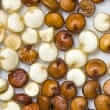Background
- Quinoa has been cultivated in the Andes Incas for thousands of years. It has recently gained prominence around the world as a "super food" due to its high protein content. Although quinoa is high in protein content, it alone does not have enough protein to replace meat in the Western European diet, due to current cultivation, technological, and processing restrictions. Quinoa is also used by some people as a substitute for wheat, especially those on a gluten-free diet due to celiac disease or other conditions.
- Other than its use as a food, there is insufficient evidence in humans to support the use of quinoa for any indication.
References
- Berti C, Riso P, Brusamolino A, et al. Effect on appetite control of minor cereal and pseudocereal products. Br J Nutr 2005;94(5):850-858.
View Abstract - Berti C, Riso P, Monti LD, et al. In vitro starch digestibility and in vivo glucose response of gluten-free foods and their gluten counterparts. Eur J Nutr 2004;43(4):198-204.
View Abstract - Cook JD, Reddy MB, Burri J, et al. The influence of different cereal grains on iron absorption from infant cereal foods. Am J Clin Nutr 1997;65(4):964-969.
View Abstract - Dijkstra DS, Linnemann AR, van Boekel TA. Towards sustainable production of protein-rich foods: appraisal of eight crops for Western Europe. PART II: Analysis of the technological aspects of the production chain. Crit Rev Food Sci Nutr 2003;43(5):481-506.
View Abstract - Hurrell RF, Reddy MB, Burri J, et al. An evaluation of EDTA compounds for iron fortification of cereal-based foods. Br J Nutr 2000;84(6):903-910.
View Abstract - Inman-Felton AE, Rottmann LH. Should millet, buckwheat, and quinoa be included in a gluten-free diet? J Am Diet.Assoc 1999;99(11):1361.
View Abstract - Jung K, Richter J, Kabrodt K, et al. The antioxidative power AP--A new quantitative time dependent (2D) parameter for the determination of the antioxidant capacity and reactivity of different plants. Spectrochim.Acta A Mol.Biomol.Spectrosc. 3-13-2006;63(4):846-850.
View Abstract - Lee P. Should millet, buckwheat, and quinoa be included in a gluten-free diet? J Am Diet.Assoc 1999;99(11):1361.
View Abstract - Linnemann AR, Dijkstra DS. Toward sustainable production of protein-rich foods: appraisal of eight crops for Western Europe. Part I. Analysis of the primary links of the production chain. Crit Rev Food Sci Nutr 2002;42(4):377-401.
View Abstract - Ogungbenle HN. Nutritional evaluation and functional properties of quinoa (Chenopodium quinoa) flour. Int J Food Sci Nutr 2003;54(2):153-158.
View Abstract - Ruales J, de Grijalva Y, Lopez-Jaramillo P, et al. The nutritional quality of an infant food from quinoa and its effect on the plasma level of insulin-like growth factor-1 (IGF-1) in undernourished children. Int J Food Sci Nutr 2002;53(2):143-154.
View Abstract - Ruales J, Nair BM. Quinoa (Chenopodium quinoa willd) an important Andean food crop. Arch Latinoam.Nutr 1992;42(3):232-241.
View Abstract - Schollenberger M, Muller HM, Rufle M, et al. Survey of Fusarium toxins in foodstuffs of plant origin marketed in Germany. Int J Food Microbiol. 1-1-2005;97(3):317-326.
View Abstract - Thompson T. Case problem: questions regarding the acceptability of buckwheat, amaranth, quinoa, and oats from a patient with celiac disease. J Am Diet.Assoc 2001;101(5):586-587.
View Abstract - Valencia S, Svanberg U, Sandberg AS, et al. Processing of quinoa (Chenopodium quinoa, Willd): effects on in vitro iron availability and phytate hydrolysis. Int J Food Sci Nutr 1999;50(3):203-211.
View Abstract







